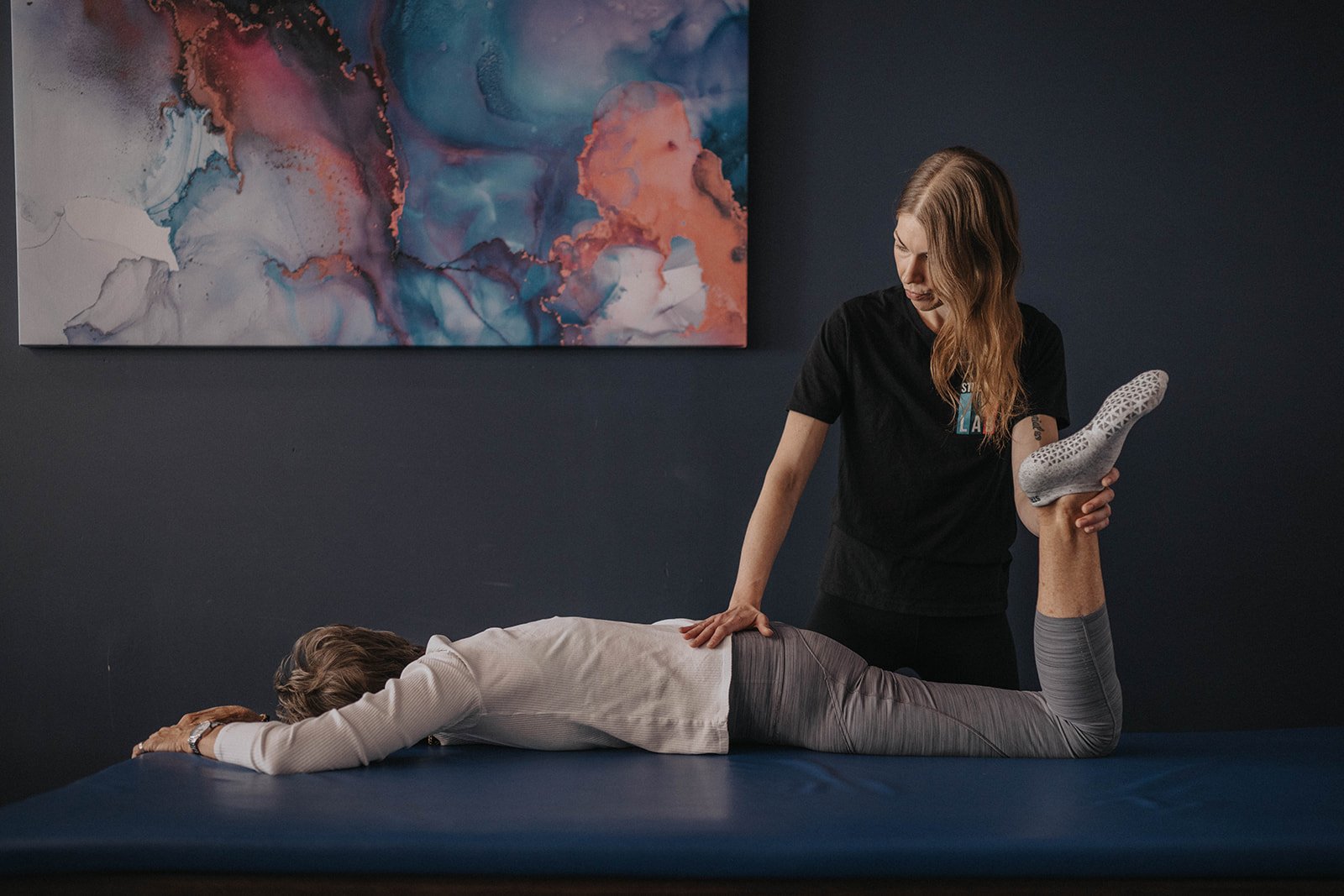Did you know that stretching isn’t just for warming up before a run or workout? It offers a number of benefits for athletes and non-athletes alike. In addition to enhancing performance and muscle balance, stretching also improves our flexibility so that we can move freely and comfortably.
Whether you're reaching for something on a high shelf, bending down to tie your shoes, or simply enjoying a leisurely stroll, flexibility plays a crucial role in how efficiently and comfortably we move throughout our day.
So, if you've ever found yourself feeling stiff or restricted in your movements, incorporating regular stretching into your routine could be the key to unlocking a whole new level of ease and comfort in your daily life. One particularly effective stretching technique is PNF stretching.
In this blog, we explore everything you need to know about PNF stretching. From what it is, to uncovering its mechanisms, benefits, techniques, and applications.
First Things First, What Exactly is PNF Stretching?
PNF stretching, also known as proprioceptive neuromuscular facilitation stretching, is a highly effective and popular technique used to improve flexibility and range of motion.
Unlike traditional stretching methods, PNF stretching combines passive stretching (where an external force is applied to lengthen the muscles) with isometric contractions (where the muscle contracts without changing length).
This means that during a PNF stretch, the muscle is stretched to its maximum length before contracting against resistance, leading to a deeper and more effective stretch. This combination of stretching and contracting helps to reset the muscle's natural length and improve its range of motion.
Physiotherapists often utilise PNF stretching to enhance muscle elasticity, and it has been shown to have a positive effect on both active and passive range of motion.
PNF Vs Static Stretching
PNF stretching and static stretching are two commonly used techniques for enhancing flexibility, but they differ in their approach and effectiveness.
Static stretching involves holding a position for a prolonged period, usually between 15 to 60 seconds, without movement or resistance. It helps to lengthen and relax muscles but may not be as effective in improving overall flexibility.
On the other hand, PNF stretching employs reciprocal inhibition, where the opposing muscle group relaxes during the stretch, allowing for a deeper and more effective stretch compared to static stretching.
While static stretching can be useful for relaxation and post-workout cooldowns, PNF stretching is considered to be more effective than static stretches for improving flexibility and enhancing athletic performance.
Read More: Dynamic Stretching vs Static Stretching
The Benefits Of PNF Stretching
PNF stretching offers a number of benefits for individuals of all fitness levels and backgrounds. Whether you're an athlete looking to improve your performance or someone who wants to enhance their overall flexibility, it is an effective tool that can help you achieve your goals. Here are some of the key benefits of incorporating PNF stretching into your fitness routine:
Increased flexibility:
PNF stretching is a highly effective technique in increasing flexibility by targeting specific muscle groups and gradually improving their range of motion. By consistently practising PNF stretches you can achieve a greater degree of flexibility, allowing you to move more freely and with less risk of injury.
Improved athletic performance:
Athletes can greatly benefit from PNF stretching as it helps to enhance muscle activation and coordination. By increasing range, improving flexibility and restoring balance in the muscles, athletes can perform at their best and reduce the risk of injuries associated with tight muscles.
Reduced muscle tension:
PNF stretching can help alleviate muscle tension and promote relaxation. The combination of stretching and contracting encourages the muscles to release tension and increases blood flow to the area, promoting faster recovery and reducing the risk of muscle imbalances.
Enhanced muscle strength:
PNF stretching not only improves flexibility but also enhances muscle strength. The isometric contractions involved engage the muscles in a way that we don’t typically engage them on a day-to-day basis, leading to increased muscle activation and improved strength.
Improved posture and body alignment:
By incorporating PNF stretching into your routine you can help improve posture and body alignment. By stretching tight muscles and strengthening weak ones, it helps to restore balance in the body, improving overall posture and alignment.
Injury prevention:
By progressively stretching the muscles and connective tissues, PNF stretching helps to improve their elasticity and reduce the risk of tears or strains. This is particularly important for athletes or those engaged in physical activities that require a high level of muscular strength and coordination.
Read More: Achieving Balance: Effective Stretching Routines for Busy Professionals
A Look At The PNF Technique
PNF stretching involves various techniques that target different muscle groups and areas of the body. These techniques can be performed with a partner or on your own using props such as resistance bands or stability balls. Here are some common techniques:
- Hold-Relax: This technique involves stretching a muscle to its maximum length and then holding the stretch while applying resistance. After holding the stretch for a few seconds, you release the tension and move into a deeper stretch.
- Contract-Relax: Similar to the Hold-Relax technique, Contract-Relax involves stretching a muscle to its maximum length. Instead of applying resistance, you contract the muscle against resistance for a few seconds before relaxing and moving into a deeper stretch.
- Hold-Relax with Agonist Contraction: This technique combines the Hold-Relax technique with an additional contraction of the opposing muscle group. After stretching a muscle and applying resistance, you contract the opposing muscle group while relaxing the stretched muscle, allowing for a deeper stretch.
- Joint Rotations: Joint rotations involve moving a joint through its full range of motion while maintaining a relaxed and controlled movement. This technique helps to improve joint mobility and increase flexibility in the surrounding muscles.
It's important to note that these stretching techniques should be performed with caution and under the guidance of a qualified instructor or flexologist. Improper stretching technique or excessive force can lead to injury. Always listen to your body and stop if you experience pain or discomfort.
Tips For PNF Stretches During A Stretching Class
Proper form is essential when performing PNF stretching. This is to ensure maximum effectiveness and minimise any risk of injury. Here are some tips to keep in mind:
- Warm-up: Before starting any stretching routine, it's important to warm up your muscles with light aerobic exercise or dynamic stretching. This helps to increase blood flow and prepare the muscles for stretching.
- Choose the right stretch: Select a PNF stretch that targets the specific muscle group you want to work on. Each stretch should be performed in a controlled and gradual manner, without forcing or bouncing.
- Apply resistance: During the stretch, apply gentle resistance to the muscle being stretched. This can be done by pushing against a partner's hand, using a resistance band, or using your own body weight.
- Hold and relax: Hold the stretch for 10-30 seconds while applying resistance. Then, relax the muscles and move into a deeper stretch, taking care not to force the movement.
- Breathe: Remember to breathe deeply and rhythmically throughout the stretch. Avoid holding your breath, as this can increase tension in the muscles.
- Repetition: Repeat each PNF stretch 2-4 times, gradually increasing the intensity and depth of the stretch with each repetition.
- Listen to your body: Pay attention to how your body responds during the stretch. If you experience any sharp pain or discomfort, ease off the stretch immediately. While it is important to push yourself slightly out of your comfort zone, it should never be to the point of causing injury.
Where You Can Find PNF Stretching
From at-home workouts to weekly gym sessions, PNF stretching can be incorporated into various settings. However, for those seeking expert guidance and personalized assistance, specialized stretching studios like Stretch Lab offer an ideal environment. These studios provide dedicated Stretch sessions conducted by trained flexologists who specialize in utilizing PNF stretching techniques to enhance flexibility and range of motion.
If you're considering attending a PNF stretch class at a studio like Stretch Lab, here's what you can typically expect:
- Warm-up: The class starts with gentle exercises to prepare muscles. No need to warm up beforehand; it's included!
- Guided stretches: The instructor leads stretches targeting different muscle groups with clear instructions.
- Assisted stretching: Instructors may help with alignment and deepen stretches, especially useful for those needing extra support.
- Progressive difficulty: Stretches become more challenging as the class goes on, aiming for ongoing improvement.
- Cool-down: The session ends with relaxation exercises to aid muscle recovery.
.jpg?width=8256&height=5504&name=077_STRETCHLAB_20220205-_DSC8625%20(1).jpg)
Elevate Your Flexibility Journey with Stretch Lab!
When it comes to improving flexibility, preventing injuries, and enhancing workout recovery, PNF stretching techniques are highly effective. By incorporating this effective technique into your fitness routine, you can unlock your body's full potential and experience the freedom of movement you deserve!
Join us at Stretch Lab for expert-led Stretch sessions conducted by our highly trained flexologists. With a variety of class options, expert instructors, and convenient locations, Stretch Lab provides the perfect environment to elevate your stretching practice!


-1.jpg?width=8087&height=5392&name=106_STRETCHLAB_20220205-_DSC8717%20(1)-1.jpg)
.jpg)
.jpg)
.jpg)


